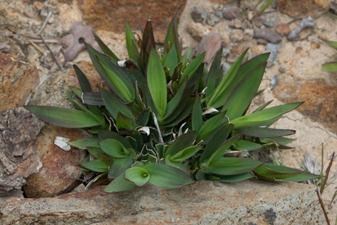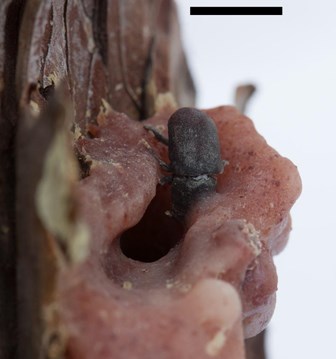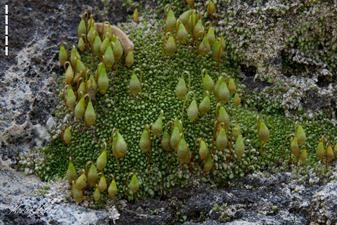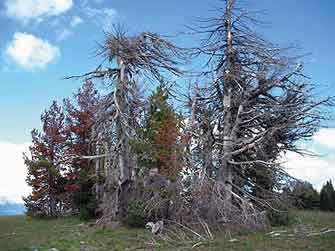
NPS Photo/ Jeremiah Reeves Jolley Lassen Volcanic's Natural Resource Managers quantify species of concern based on Federal, CA State, and CA Native Plant Society rankings, abundance, and threat. Among the greatest threats to Lassen's plants are climate change, competition with invasive plants, and historical fire suppression. 
NPS Photo/ Martin Hutten Geysers Panicum Grass
Certain plants thrive in Lassen's hydrothermal areas, including geysers panicum grass (Panicum acuminatum var. thermale), the state-listed endangered plant. Boiling mudpots, hissing steam vents, and bubbling springs do not appear to be an ideal habitat for vegetation. However, Panicum can be easily spotted on the shores of Boiling Springs Lake and near Terminal Geyser. Unfortunately, non-native / invasive cheatgrass also loves the area, threatening the already rare Panicum. 
NPS Photo/ Martin Hutten 2010 through 2014 has marked a period of prolonged drought in Lassen Volcanic. Meanwhile, a century of fire suppression has allowed white firs to infiltrate into the park's historically Jeffrey pine (Pinus Jeffreyi) forests. The abundance of white fir, coupled with the drought and development-related stress have allowed an abnormal number of park old growth Jeffrey pines in the Manzanita Lake campground area to fall susceptible to the native Jeffrey pine beetle. Although this beetle normally attacks older, weaker trees, we are now seeing otherwise healthy trees being killed from infestations.
The National Park Service and National Forest Service began collaborating on this project in 2013 and continue to install synthetic anti-aggregation pheromone on the larger legacy Jeffrey pine trees in the Manzanita Lake campground. These pheromone pouches signal to other beetles that, "this tree is full, move on!" The park implements further treatments in the spring, such as the removal of green infested trees, to reduce beetle spread at the start of flight season. In addition to the recent drought, Lassen Volcanic and surrounding areas are experiencing significant reductions in precipitation and snowpack accumulation, as well as earlier springs by one to four weeks on a climatic scale, increasing concern for the park's ancient forests long term.
Read more information on the Jeffrey pine beetle and other CA Forest Pest Conditions (29.3 MB, pdf), as of 2013. 
NPS Photo/ Martin Hutten 
NPS Photo/ Crater Lake Lassen Volcanic National Park, home to currently healthy whitebark pine populations, could become a potential refuge to a declining tree species affected elsewhere by the white pine blister rust pathogen, mountain pine beetle, and climate change. On July 18, 2011, the Fish and Wildlife Service determined that whitebark pine (Pinus albicaulis) warrants protection under the Endangered Species Act due to the fact that it faces an “imminent” risk of extinction. It has been added to the list of candidate species eligible for protection, and its status will be reviewed annually. This 2011 determination is significant because it marks one of the first times the federal government has identified climate change--linked to warming and drought--as a factor for why a species could disappear. In the greater Yellowstone area, a recent study found that 80 percent of whitebark pine forests there are dead or dying. It is uncommon for a tree to receive such a high level of federal protection; however, whitebark pine is a major component of upper subalpine forests throughout the Cascades, Sierras, and Rockies. The Southern Cascades is one region in the species’ entire range where it is relatively stable. In Lassen, it grows at the top of the tree line, often in stunted krummholz stands, such as near Bumpass Hell and Lassen Peak. It grows on cold, windswept sites, environments often too harsh for other species to thrive. The only North American member of the “stone pines,” whitebark pine depends entirely upon the Clark’s nutcracker for dispersal of its large, wingless seeds. Whitebark pine acts as both a foundation and keystone species in high-elevation forest communities by providing a high-energy food resource for wildlife, regulating ecosystem processes particularly as they relate to soil retention and water quality, community composition and dynamics, and by influencing regional biodiversity. The Klamath Inventory and Monitoring network currently conducting an inventory of whitepark pines in both Lassen Volcanic National Park and Crater Lake National Park.
|
Last updated: November 8, 2019
